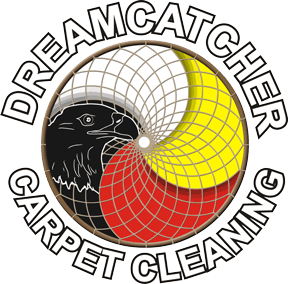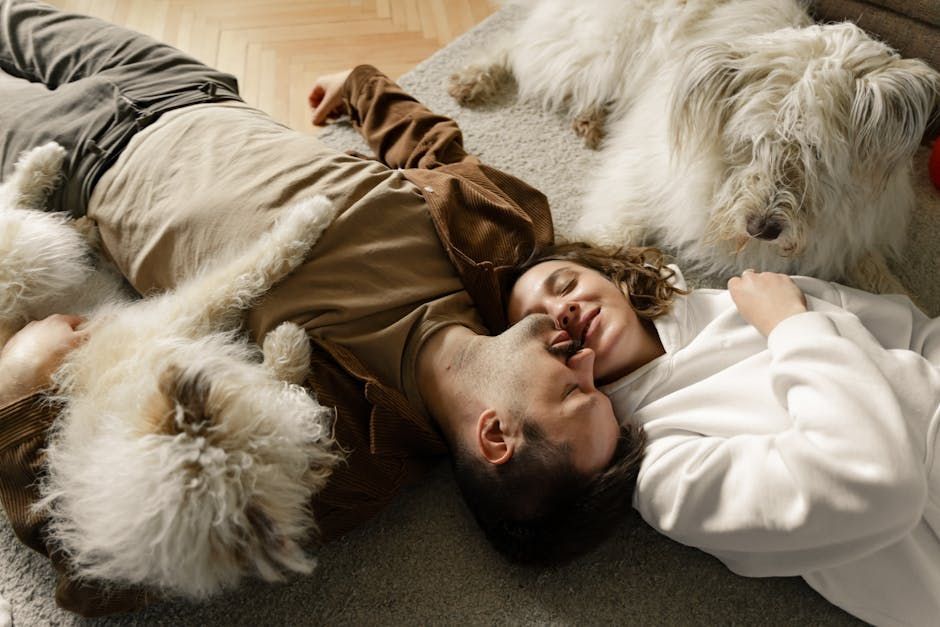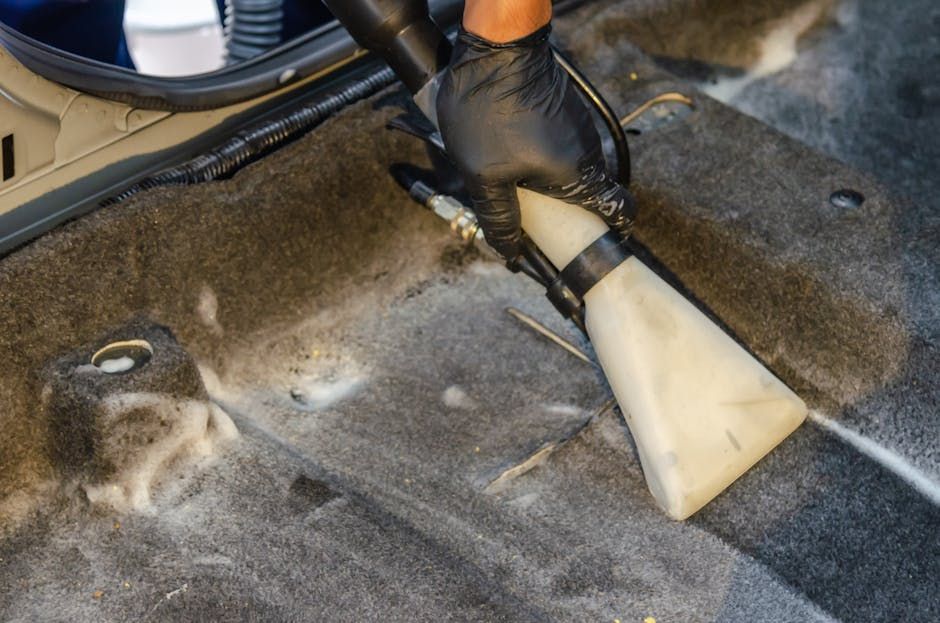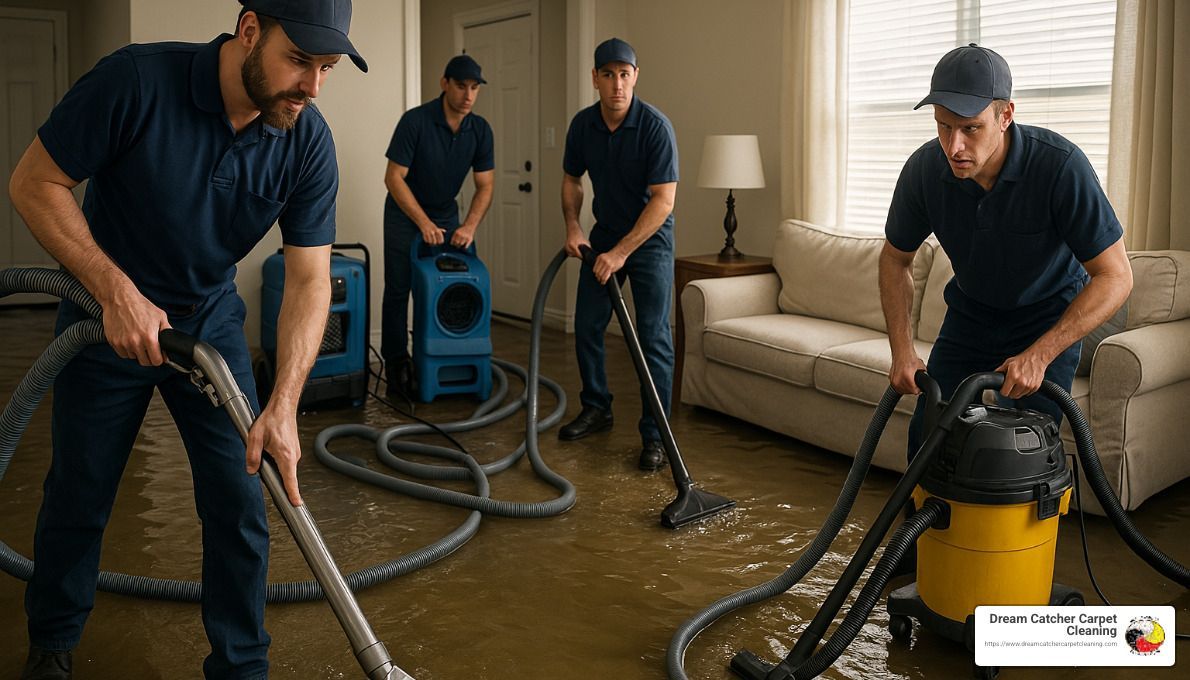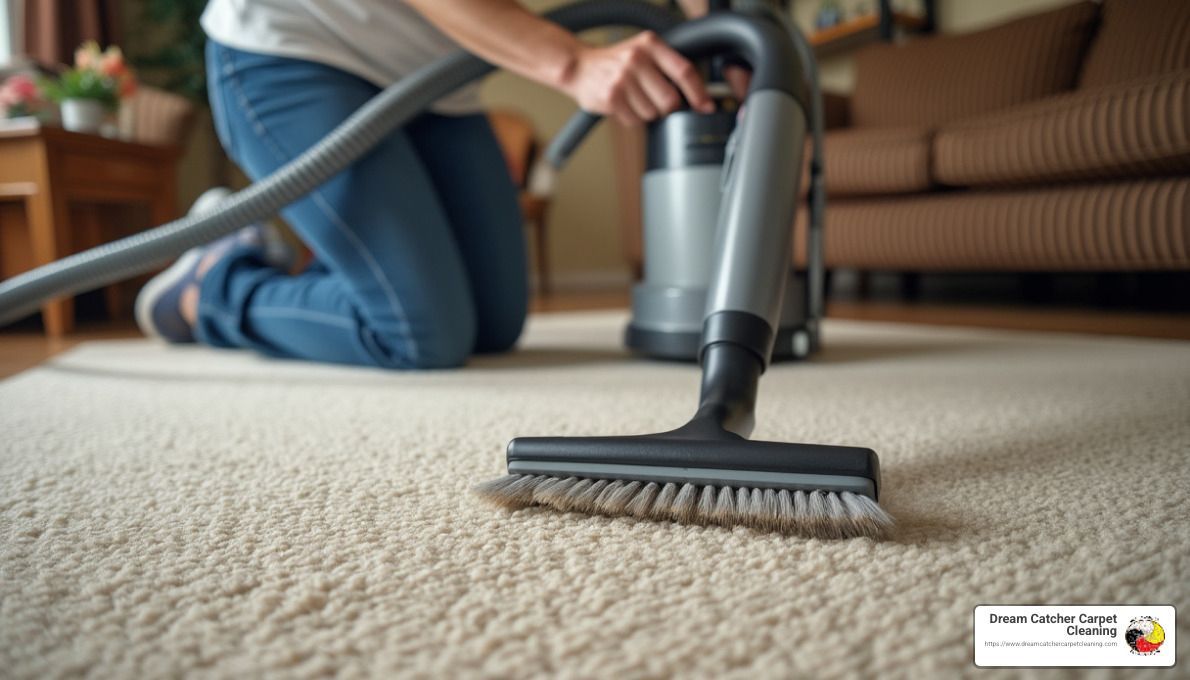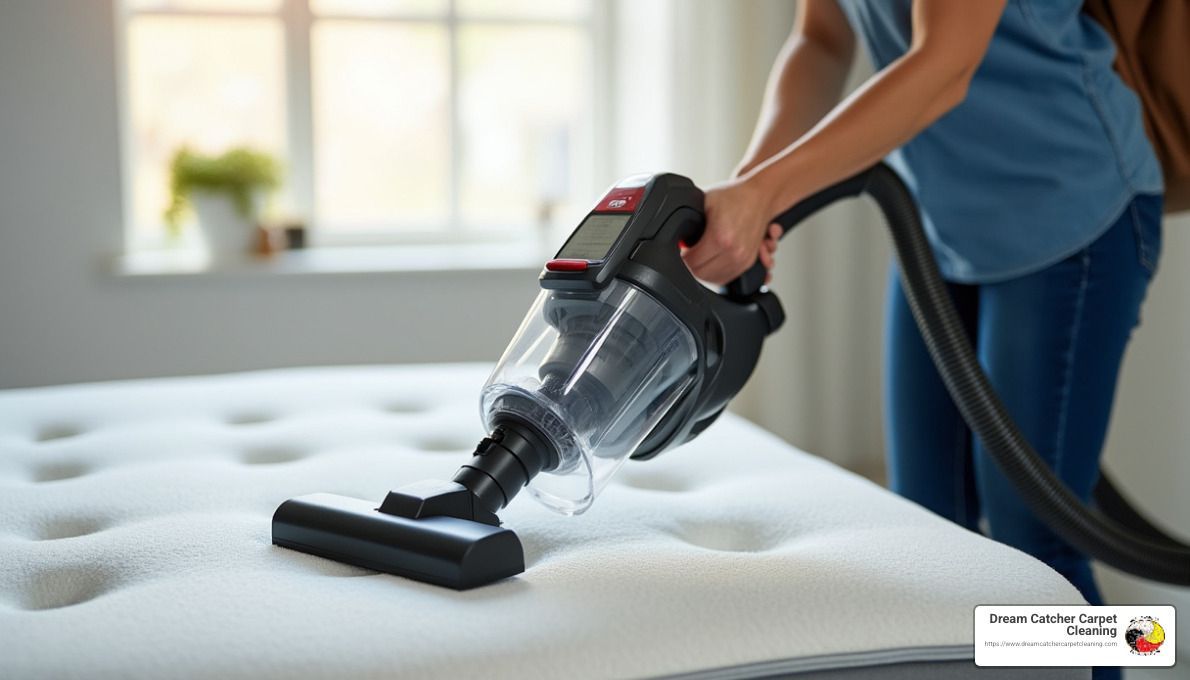The Persistent Problem of Pet Odors
Dog urine smell in house is one of the most challenging and embarrassing problems pet owners face.
When your beloved pet has an accident indoors, that unmistakable ammonia odor isn't just unpleasant—it's persistent. The smell lingers because dog urine contains uric acid crystals that bind to surfaces and reactivate with moisture, keeping the odor alive long after you think you've cleaned it up.
Unlike regular dirt or spills, dog urine smell in house problems require specialized cleaning approaches because the urine components break down over time, releasing stronger ammonia compounds. This process can continue for months or even years if not properly addressed, making your whole house smell despite your best cleaning efforts.
What makes this issue particularly frustrating is that dogs can detect these odors even after we think they're gone, often leading them to "mark" the same spots repeatedly. This creates a cycle that's difficult to break without the right techniques and products.
I'm Clarence Smith, owner of Dream Catcher Carpet Cleaning with over 22 years of experience tackling stubborn dog urine smell in house problems for homeowners throughout the Denver area. My IICRC certification and specialized training in pet odor removal have helped countless families restore freshness to their homes.
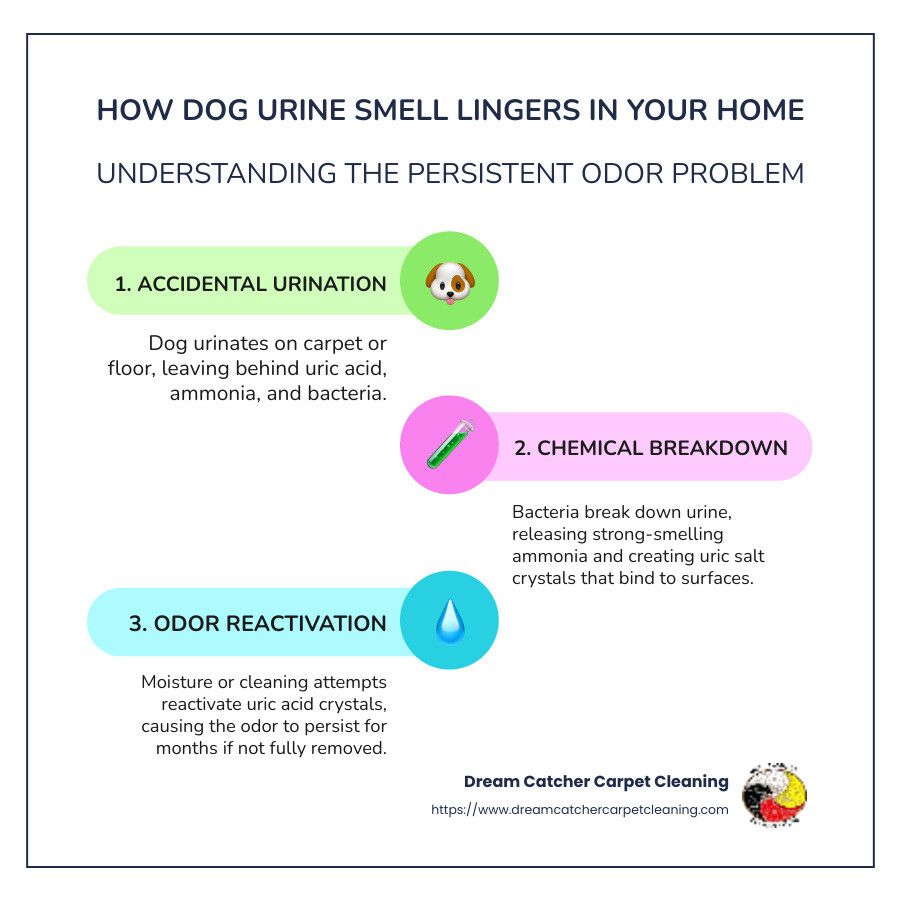
Why Dog Urine Smell Lingers
Ever walked into your home and been hit with that unmistakable "dog bathroom" aroma—even after you've cleaned and cleaned? You're not imagining things, and you're definitely not alone in this frustrating experience.
The truth is, dog urine smell in house problems are incredibly persistent for scientific reasons that go beyond ordinary dirt or spills. When your furry friend has an accident indoors, they're leaving behind a complex chemical cocktail that's designed by nature to be noticed and remembered.
Fresh dog urine starts out acidic (pH 5-6), but as bacteria get to work breaking down the urine components, they produce ammonia—shifting to a highly alkaline pH that can reach 11 or higher. This dramatic pH change is part of what creates that sharp, distinctive odor that seems to cut through everything else in your home.
What's concerning is that according to OSHA guidelines, exposure to ammonia at just 50 parts per million can be harmful to human health—and concentrated pet urine in enclosed spaces can easily exceed these levels.
"The real culprit behind persistent dog urine smell in house is uric acid," explains our senior technician at Dream Catcher Carpet Cleaning. "Unlike other urine components that water-based cleaners can handle, uric acid forms crystals that bind tightly to surfaces. These crystals are remarkably resilient—they can lie dormant until activated by moisture, even just humidity in the air."
This explains why your home might suddenly smell worse on rainy days, or why the odor comes roaring back after you've steam-cleaned your carpets. The moisture simply wakes up those sleeping crystals, and the smell cycle begins again.
The Science Behind the Stench
The chemistry behind persistent dog urine smell in house problems is fascinating—if incredibly frustrating for homeowners. When your dog has an accident, several processes begin immediately:
First, bacteria start breaking down urea in the urine into ammonia compounds, creating that sharp, eye-watering smell. Meanwhile, the uric acid in the urine forms nearly insoluble crystals that bond tightly to carpet fibers, padding, subflooring, and even grout.
These urine salt crystals are hygroscopic—meaning they actively attract and absorb moisture from the air. Each time they get wet (even from normal household humidity), they release more odor molecules into your home. It's like having tiny, hidden odor bombs that can reactivate for months or even years.
Adding to this problem, dog urine contains pheromones that serve as chemical messages to other dogs. While humans can't detect these pheromones directly, they signal to your pet that this spot is a "marked" territory. This often encourages repeat accidents in the same location, creating a frustrating cycle that's difficult to break without specialized cleaning.
A Westminster client shared her experience: "I thought I was going crazy! I cleaned the same entryway spot at least ten times with regular carpet cleaner, but my dog kept returning to it like it was his personal bathroom. It wasn't until I learned about pheromones and used enzymatic cleaners that we finally broke the cycle."
Health Hazards You Should Know
That persistent dog urine smell in house isn't just embarrassing when company comes over—it can actually impact your family's health, especially with prolonged exposure.
The ammonia released from decomposing urine is a respiratory irritant that can trigger or worsen asthma symptoms, bronchitis, and other breathing problems. Many people experience headaches, irritated eyes, or nausea when exposed to strong ammonia odors, even if they don't recognize the source.
Untreated urine spots can become breeding grounds for mold and bacteria, particularly in carpet padding or subflooring where moisture lingers. This creates additional allergens and can lead to more serious health concerns over time. In rare cases, dog urine can contain Leptospirosis bacteria, which poses risks to human liver and kidney health if contacted repeatedly.
Children, seniors, and people with compromised immune systems or existing respiratory conditions are particularly vulnerable to these effects. Research shows that even inhaling the threshold limit of 50 ppm of ammonia can be harmful—making proper removal of dog urine smell in house a genuine health priority, not just an aesthetic one.
A Boulder family finded this connection firsthand: "My son's asthma attacks became more frequent, and we couldn't figure out why until we finded our aging dog had been having accidents behind the furniture for months. Once we properly treated those areas with enzymatic cleaners, his symptoms improved dramatically."
Understanding why these odors persist is the first step in effectively eliminating them—which is exactly what we'll tackle in the following sections.
For more detailed information about the health impacts of ammonia exposure, you can check out this comprehensive guide from Everyday Health.
Detecting Hidden Urine Spots
Finding all the affected areas might be the trickiest part of tackling dog urine smell in house problems. Our furry friends are notorious for sneaking off to do their business in hidden corners, underneath furniture, or in rooms we rarely visit. What makes this detective work even harder is that old urine stains often become invisible to our eyes while continuing to release that unmistakable odor.
The secret weapon in this smelly treasure hunt? A UV black light (sometimes called a UV flashlight). When you darken a room and switch on this special light, urine residue lights up with an eerie yellowish-green glow that's impossible to miss. This simple tool reveals the true extent of the problem that your nose might have suspected but your eyes couldn't confirm.
One of our Denver clients shared her eye-opening experience: "I was absolutely shocked when we turned off the lights and used the black light. What I thought was just one small accident spot turned out to be multiple areas all along the baseboards and even up the wall where my dog had been marking his territory. No wonder I couldn't get rid of the smell!"
Tools You'll Need
Before you begin your odor investigation, gather these essential items to make the process effective:
A good quality UV flashlight with 365-395nm wavelength will give you the clearest results when hunting for urine spots. Once you've found them, you'll want chalk or painter's tape to mark the boundaries so you don't lose track when the lights come back on.
For serious cases, especially on hardwood or subfloors, a moisture meter can help determine how deep the urine has penetrated. Always keep paper towels or microfiber cloths handy for testing suspicious areas, and don't forget to protect yourself with gloves whenever you're dealing with pet waste or cleaning chemicals.
Many of our customers find it helpful to document findings in a notebook or phone app, creating a "urine map" that ensures no spot gets overlooked during cleaning. At Dream Catcher Carpet Cleaning, we use professional-grade detection equipment as part of our assessment process, ensuring we find every trace of urine before beginning treatment.
Mapping Old Accidents Before Cleaning
Creating a comprehensive map of affected areas requires a methodical approach. Start by making the room as dark as possible—close curtains and turn off all lights for the best black light results. Then, slowly scan the UV light across floors, baseboards, and walls (up to about 2 feet high), paying special attention to furniture skirts and even drapes.
As you find spots that fluoresce under the black light, mark each area with chalk or painter's tape. This visual reminder will be invaluable when you begin cleaning. Urine doesn't always stay where it lands—it often runs beneath baseboards or seeps into wall cavities, so check adjacent rooms if you find stains near walls.
"The most commonly missed areas are vertical surfaces," explains our senior technician. "The lower portions of walls, sides of furniture, and draperies often get marked, especially by male dogs, but homeowners typically only clean the floor."
In severe cases, consider pulling back carpet in a corner to check if urine has penetrated to the padding or subfloor. This deeper investigation can reveal why odors persist despite surface cleaning. By taking time to thoroughly map all affected areas before cleaning, you'll ensure your efforts address the entire problem, not just the obvious spots.
For particularly stubborn or extensive dog urine smell in house issues, this mapping phase is where professional expertise can make a significant difference. Our technicians are trained to detect even the faintest traces of old urine that might be missed during DIY inspection.
Immediate Action Plan: Fresh Accidents
We've all been there - you turn around just in time to catch Fido in the act, or worse, step in a fresh "surprise" on your way to the kitchen. When fresh accidents happen, quick action is your best friend in preventing a persistent dog urine smell in house problem from developing. The good news? You can tackle this effectively with items you probably already have at home.
The most crucial first step is removing as much liquid as possible before it has a chance to soak deep into your floors or furniture. This isn't just about the visible stain - it's about preventing that ammonia smell from becoming a permanent resident in your home.
Step-by-Step Blotting Guide
Think of blotting as the gentle giant of cleaning techniques. When I find a fresh accident at a client's home in Thornton, I always demonstrate proper blotting technique because it makes such a difference in the outcome.
Start by grabbing a stack of paper towels or absorbent cloths and press down firmly on the wet spot. Avoid the temptation to rub or scrub - this actually pushes urine deeper into fibers and spreads the problem. Instead, work from the outer edges of the wet area toward the center, which prevents the urine from spreading further.
For maximum absorption, try the towel stack method that works wonders. Layer several paper towels over the spot, then stand on them (with shoes on, of course!) to apply pressure. The weight forces more liquid up into the towels. Remove the wet towels, replace with fresh ones, and repeat until they come up nearly dry.
One of our clients in Westminster swears by what we call the newspaper layer technique: "After blotting up the initial mess, I laid down newspaper, covered it with a towel, and put my heavy plant pot on top overnight. By morning, the newspaper had drawn out moisture I didn't even know was there!"
Safe First-Aid Cleaners in Your Pantry
After you've blotted up as much urine as possible, your kitchen pantry can provide some effective first-aid treatments before you do a deeper clean.
White vinegar is your first line of defense. Mix equal parts white vinegar and cool water in a spray bottle, then lightly mist the area. The acidity in vinegar helps neutralize the alkaline salts in urine that cause odors. Let it sit for about 5-10 minutes, then blot dry with clean towels. Don't worry about the vinegar smell - it dissipates as it dries, taking the urine odor with it.
Once the vinegar solution has dried, sprinkle a generous amount of baking soda over the area. This wonderful powder absorbs odors rather than masking them. Let it sit for several hours or, ideally, overnight before vacuuming thoroughly. The longer it sits, the more odor it absorbs.
For tougher spots, a hydrogen peroxide mixture can work wonders, but always test it on an inconspicuous area first to check for colorfastness. Mix 3% hydrogen peroxide with a few drops of dish soap, apply lightly to the stain (don't soak it), and blot dry after about 15 minutes.
A mom from Broomfield told us: "My puppy had an accident on my daughter's favorite play rug. I was in a panic, but remembered your advice about pantry cleaners. The vinegar and baking soda combo saved the day - and the rug! My daughter never knew the difference."
These household solutions work best as immediate treatments for fresh accidents. For older stains or persistent dog urine smell in house problems that have had time to set in, you'll need the more powerful solutions we'll cover in the next section. The key is acting quickly - the sooner you address the accident, the better your chances of preventing long-term odor issues.
Deep-Cleaning Methods to Remove Dog Urine Smell in House
When your first-aid cleaning attempts haven't quite conquered that persistent dog urine smell in house, don't worry—it's time to bring out the bigger guns. The lingering odor isn't your fault—those stubborn uric acid crystals are notoriously difficult to eliminate with regular cleaning methods.
How Enzymatic Cleaners Tackle Dog Urine Smell in House
Think of enzymatic cleaners as tiny, odor-eating superheroes. Unlike regular cleaners that just mask smells, these specialized solutions actually break down the source of the odor at a molecular level.
"Enzymatic cleaners were absolutely life-changing for us," shares Maria from Northglenn. "After months of fighting with our rescue dog's accident spots, I was ready to replace all our carpets. The enzyme treatment saved us thousands of dollars!"
These cleaners work through a fascinating biological process. They contain beneficial bacteria that produce specific enzymes designed to "eat" organic waste—specifically the uric acid crystals that cause that persistent dog urine smell in house. As these enzymes work, they break the uric acid down into simple gases that evaporate completely, leaving no residue behind.
For enzymatic cleaners to work their magic properly, follow these crucial steps:
First, thoroughly clean the area to remove any surface debris. Then generously saturate the spot—and I mean really soak it—so the solution reaches everywhere the urine did. This is critical because urine typically seeps deeper than you might think.
Next, cover the area with plastic wrap or a damp towel. This prevents the solution from drying out too quickly, giving those hardworking enzymes time to do their job. Let it work for at least 15 minutes, but for stubborn spots, overnight treatment works wonders.
Remember to avoid using heat before or after applying enzymatic cleaners. Heat can both set urine stains and kill the beneficial bacteria in your cleaner, rendering it much less effective.
DIY Solutions vs Store-Bought: What Works for Dog Urine Smell in House
While I've seen great results with commercial enzyme cleaners, many of my clients prefer trying DIY solutions first, especially for minor accidents.
The classic vinegar and baking soda approach works reasonably well for fresh stains. Mix equal parts white vinegar and water, spray generously, then sprinkle baking soda over the area once it's nearly dry. The vinegar helps neutralize the ammonia smell, while baking soda absorbs remaining odors. It's inexpensive and non-toxic, but honestly, it struggles with severe or old urine deposits.
Some ambitious homeowners make homemade citrus enzyme cleaners by fermenting fruit peels with sugar and water. While environmentally friendly, these take months to prepare and yield inconsistent results. They're better for general cleaning than tackling serious dog urine smell in house problems.
Commercial enzymatic cleaners typically deliver the most reliable results. They cost between $10-30 per bottle but are specifically formulated to break down pet urine components. The science behind these products is impressive—they contain precise enzyme blends that target protein, uric acid, and other urine components.
At Dream Catcher Carpet Cleaning, we use professional-strength enzymatic solutions that are more concentrated than what's available in stores. This allows us to tackle even the most challenging pet odor situations effectively.
Surface-Specific Tactics
Different surfaces in your home require custom approaches for eliminating dog urine smell in house:
For carpets and rugs, start by extracting as much liquid as possible with a wet vacuum. Then apply an enzymatic cleaner, allowing proper dwell time for it to work. In severe cases where urine has soaked through to the padding, you might need padding replacement. No amount of surface cleaning can fix deeply saturated padding, which acts like a urine reservoir.
Hardwood floors require extra care since excessive moisture can cause damage. Blot up accidents immediately, then clean with a hardwood-safe enzymatic product. Avoid steam cleaners or soaking the wood. For persistent odors, light sanding and refinishing might be necessary. One client in Louisville had to replace several floorboards where her elderly dog's repeated accidents had seeped deep into the wood.
Upholstered furniture can be particularly challenging. Always check the manufacturer's cleaning codes before treating. Use fabric-safe enzyme cleaners and ensure complete drying to prevent mildew. For valuable pieces, professional cleaning is often worth the investment.
For tile and grout, pay special attention to those grout lines—they're porous and absorb urine like a sponge. Apply enzymatic cleaner liberally to the grout, allowing extra time for it to penetrate. For persistent odors, you might need to consider grout sealing or replacement.
Concrete surfaces in garages or basements present unique challenges since they're extremely porous. Scrub thoroughly with enzymatic cleaner, applying multiple treatments for severe cases. After cleaning, consider applying a concrete sealer to prevent future absorption.
"We were at our wits' end with the basement concrete where our puppy had accidents during training," recalls Tom from Broomfield. "Regular cleaners did nothing, but the enzymatic treatment followed by sealing the concrete completely solved our dog urine smell in house problem."
By using the right approach for each surface in your home, you'll have the best chance of permanently eliminating pet odors and keeping your home fresh and welcoming.
When Odor Persists: Professional Help & Replacement Decisions
Let's be honest—sometimes, despite your best efforts and multiple bottles of enzymatic cleaner, that stubborn dog urine smell in house just won't budge. This usually means the urine has penetrated far deeper than you can reach with retail products, or the damage has become too extensive for DIY solutions.
Signs It's Time to Call the Pros
Trust me, I've seen the frustration on homeowners' faces when they've tried everything in their power before finally calling us. One Arvada homeowner recently told me, "I spent three weekends in a row trying different products, and the smell would disappear for a day, then come right back stronger than before!"
You might need professional help if you notice the odor returns within days of cleaning—this typically indicates deep contamination below the surface. Similarly, if you've made multiple cleaning attempts with quality enzymatic products without success, deeper issues are likely at play.
Pay attention to your family's health, too. Persistent respiratory irritation, headaches, or allergy symptoms that don't improve after cleaning suggest you haven't fully addressed the problem.
Visible staining that won't fade even after treatment is another red flag. When you pull back carpet and find padding that's discolored yellow or brown (or worse, still damp), that's a clear sign the urine has penetrated too deeply for surface cleaning.
Look for physical damage to your floors as well—buckling hardwood, separated vinyl seams, or white powdery spots on concrete are all indicators of severe contamination. And if that dog urine smell in house problem intensifies dramatically every time it rains or humidity rises, those dormant uric acid crystals are reactivating with the moisture.
What Pros Do Differently
At Dream Catcher Carpet Cleaning, we approach pet odor problems with tools and techniques that simply aren't available to most homeowners. Our truck-mounted extraction systems deliver significantly more cleaning power and suction than portable units, allowing us to remove contaminants from deep within your flooring.
We use commercial-grade UV detection equipment that reveals even trace amounts of urine invisible to standard black lights. This comprehensive mapping ensures we don't miss a single spot. Our specialized injection tools can deliver cleaning agents deep into padding and subfloors where urine often migrates.
One of our most valuable tools is moisture mapping technology. Using professional moisture meters and thermal imaging, we can detect hidden dampness in areas you'd never suspect—like inside wall cavities where male dogs sometimes mark.
"I was blown away when the Dream Catcher technician showed me the moisture reading on our dining room wall," shared a Louisville client. "Our dog had been marking the corner for months, and the urine had actually wicked up inside the drywall almost two feet. No wonder our room still smelled despite cleaning the visible stain!"
Our comprehensive treatment approach makes all the difference too. We don't just clean the surface—we use sub-surface extraction techniques that reach padding and subfloors where the worst contamination often lurks. We adapt our methods based on your specific flooring type to ensure safe, effective treatment without causing damage.
In severe cases, we can safely remove and replace contaminated padding while treating the subfloor beneath—something that's extremely difficult to accomplish as a DIY project. We also have access to professional-strength odor neutralizers that are far more effective than retail versions.
Perhaps most importantly, we provide expert assessment of your specific situation. We can evaluate the full extent of contamination, determine whether materials can be saved or need replacement, identify secondary issues like mold or wood rot, and give you an honest cost-benefit analysis of different treatment options.
When replacement becomes necessary, we help with removing contaminated materials, cleaning and sealing subfloors before new installation, recommending pet-friendly replacement options, and coordinating with flooring installers to make the process as smooth as possible.
Professional treatment typically ranges from $150-$500 for spot treatments to $1,000-$3,000 for whole-room remediation, depending on severity and surfaces involved. While this represents a significant investment, it's often more cost-effective than repeated DIY attempts or prematurely replacing your flooring—only to have the odor return because the underlying issue wasn't properly addressed.
As one Broomfield customer put it: "After spending nearly $600 on different cleaning products over six months, I wish I'd just called Dream Catcher first. Their treatment cost more upfront but actually solved the problem permanently. That's value I would have gladly paid for months earlier!"
More info about professional vs DIY odor removal
Prevention & Maintaining a Fresh Home
Let's face it—the best solution for dog urine smell in house problems is preventing them in the first place! After helping thousands of Denver-area homeowners tackle pet odors, I've seen how a good prevention strategy can save you time, money, and a whole lot of frustration.
Think of prevention as a three-part approach: training your furry friend, setting up your home for success, and maintaining a consistent cleaning routine. When these three elements work together, you'll enjoy a fresh-smelling home that both you and your dog can feel good about.
Training and Medical Considerations
The foundation of preventing dog urine smell in house issues starts with proper training and health care. Your dog isn't having accidents to upset you—there's usually a reason behind the behavior.
Positive reinforcement training works wonders for most dogs. When your pup does their business outside, make it a celebration! Immediate praise, treats, and excitement help them connect outdoor elimination with good things. Consistency is key here—the more predictable your response, the faster they'll learn.
Creating a consistent bathroom schedule helps tremendously. Dogs thrive on routine, so taking them out first thing in the morning, after meals, before bedtime, and at regular intervals throughout the day sets them up for success. For puppies, a good rule of thumb is that they can hold their bladder for about one hour per month of age (up to about 8 hours).
Crate training can be your best friend during housebreaking. Dogs naturally avoid soiling their sleeping area, making a properly-sized crate an excellent training tool. Just remember—the crate should never be used as punishment, but as a comfortable, safe space.
Don't overlook medical issues that might be causing accidents. A client in Louisville shared this experience with me: "After our third carpet cleaning in six months, your technician suggested we have our 8-year-old dog checked by a vet. It turned out she had a UTI that was causing her to have accidents. After treatment, the problem completely stopped."
For senior dogs, age-related incontinence is common and should be approached with compassion. Special doggy diapers, more frequent outdoor breaks, or medication prescribed by your vet can help manage this natural part of aging.
Home Setup for Success
Your home environment plays a huge role in preventing dog urine smell in house problems. A few smart choices can make accidents less likely and easier to clean when they do happen.
Washable rugs and furniture covers are game-changers for pet owners. Instead of panicking when accidents happen on your favorite sofa or rug, you can simply toss the cover in the washing machine. Look for materials specifically designed for pet households—they're often more durable and stain-resistant.
Proper ventilation throughout your home helps reduce humidity that can reactivate old urine crystals. Opening windows regularly (weather permitting) and using ceiling fans promotes air circulation that carries odors away.
Consider investing in a quality air purifier with HEPA filtration and activated carbon. These machines continuously remove odor particles and allergens from the air, making a noticeable difference in how fresh your home smells. I recommend placing them in rooms where your dog spends the most time.
If you're planning to replace flooring, this is an opportunity to choose pet-friendly options. Luxury vinyl plank, ceramic tile, or specially treated carpet with moisture-resistant backing can all stand up to occasional accidents better than traditional materials. The right flooring choice now can save you headaches for years to come.
Scheduling regular professional cleaning every 6-12 months helps remove accumulated pet residues before they become problematic. At Dream Catcher Carpet Cleaning, we often see that homes maintained with regular professional cleaning have far fewer serious odor issues than those cleaned only when problems become obvious.
Daily & Weekly Odor-Control Habits
Creating a routine for maintaining freshness makes a world of difference in preventing dog urine smell in house issues from taking over. These habits take just minutes each day but yield significant results.
On a daily basis, vacuum high-traffic areas with a HEPA-filter vacuum to remove pet hair and dander that can trap odors. Quickly wipe down areas where your dog spends lots of time, and ensure they get regular outdoor bathroom breaks throughout the day.
Weekly maintenance should include laundering pet bedding in hot water with an enzymatic detergent that breaks down any trace urine or body oils. Take time to vacuum thoroughly under furniture and along baseboards where odor-causing debris often accumulates. It's also smart to check previously affected areas for any signs of odor return—catching problems early makes them much easier to address.
For monthly tasks, change your HVAC filters to prevent odor recirculation throughout your home. Clean or replace air purifier filters according to the manufacturer's recommendations. Many of our clients find it helpful to do a quick inspection with a black light once a month to catch any small accidents that might have been missed.
A Denver homeowner shared this success story: "After your team's deep cleaning, we implemented your suggested maintenance routine. The weekly checks with a black light helped us catch a few small accidents early, and six months later, our home still smells fresh despite having three dogs."
Make Cleaned Areas Unattractive
Dogs often return to the same spots for accidents because of lingering pheromones or established habits. Breaking this cycle is crucial for long-term success in preventing dog urine smell in house problems.
Commercial repellents use scents dogs find unpleasant but are typically inoffensive to humans. These can be effective boundary-setters while you're reinforcing proper elimination habits. If you prefer natural solutions, DIY deterrents can work well too. A simple citrus spray (1 cup water mixed with 2 tablespoons of citrus essential oil) or vinegar solution (equal parts vinegar and water) can discourage return visits to problem areas.
For stubborn cases, temporary physical barriers like aluminum foil, plastic carpet runners placed nubby-side down, or double-sided tape can make areas less appealing. Dogs typically dislike the texture of these materials underfoot.
One of the most effective strategies is changing the association your dog has with previously soiled areas. Try feeding them or playing with them in these spots to create positive connections instead of bathroom associations.
While retraining, consider supervised access to problem areas. Gradually increase freedom as new habits form, setting your dog up for success rather than failure. Remember—prevention is always easier than cleaning up afterward!
As one of our behavior specialists explains: "The key is consistency. Dogs thrive on routine, so combining deterrents with positive reinforcement for appropriate elimination creates a clear message about where they should and shouldn't go."
With these prevention strategies in place, you'll be well on your way to maintaining a fresh, clean home that both you and your four-legged family members can enjoy without embarrassing odors.
Frequently Asked Questions about Dog Urine Odor
How long can untreated urine smell last?
That lingering dog urine smell in house can be incredibly persistent—much longer than most homeowners realize. Without proper treatment, these odors can actually last up to five years! This surprising longevity comes from those stubborn uric acid crystals that simply refuse to break down on their own.
Think of these crystals as tiny time-release odor capsules. They can remain dormant for months or even years, then suddenly "reactivate" when exposed to moisture. This explains why you might notice stronger urine smells during humid summer days or after regular carpet cleaning that dampens but doesn't actually break down these crystals.
I remember a family in Broomfield who called us about a persistent odor problem. They told me: "We bought our home over a year after the previous owners moved out, and we could still smell their dog's accidents! We thought the smell would eventually fade, but it never did." Only after we performed a complete enzymatic treatment did the embedded odors finally disappear.
Can smelling dog urine make you sick?
Unfortunately, yes—that dog urine smell in house isn't just unpleasant, it can actually impact your family's health. As urine breaks down, it releases ammonia, which is a known irritant to your respiratory system, eyes, and skin. According to OSHA guidelines, even relatively low ammonia levels (50 ppm) can cause noticeable irritation.
If you're living with untreated pet urine odors, you might experience:
- Headaches or nausea that seem to worsen when you're at home
- Irritated eyes, scratchy throat, or persistent coughing
- Flare-ups of asthma or other breathing conditions
- Skin irritation in areas that contact contaminated surfaces
These risks are especially concerning for vulnerable household members like children, elderly adults, or anyone with respiratory conditions or compromised immunity.
One particularly memorable case involved a family whose young daughter was having unexplained asthma attacks. After we finded and treated extensive urine contamination hidden in her bedroom carpet and padding, her symptoms dramatically improved. Her pediatrician later confirmed that the ammonia exposure was likely triggering her breathing difficulties all along.
Do vinegar and baking soda really work?
Vinegar and baking soda have earned their reputation as household cleaning staples for good reason—they can be effective for fresh accidents and mild dog urine smell in house problems. However, they do have significant limitations when dealing with serious or long-standing odor issues.
These pantry staples work well for certain situations because vinegar's acidity helps neutralize ammonia's alkaline nature, while baking soda excels at absorbing odors from both the air and surfaces. Both are non-toxic, pet-safe, and budget-friendly options that most homeowners already have on hand.
Where they fall short, however, is their inability to break down those persistent uric acid crystals—the real culprits behind long-term odor problems. Think of it like this: vinegar and baking soda might mask the smell temporarily, but enzymatic cleaners actually digest the source of the odor.
"I recommend vinegar and baking soda as great first-response tools," I often tell homeowners. "If you catch your pet in the act or find a fresh accident, these household remedies can work wonders. But for spots where your dog has repeatedly urinated or for set-in stains, you'll need enzymatic cleaners to break down what vinegar and baking soda simply can't touch."
For best results with the vinegar and baking soda method, blot up as much urine as possible first, then apply a 1:1 solution of white vinegar and water. Let it sit for 5-10 minutes before blotting dry. Afterward, sprinkle a generous amount of baking soda over the area, allow it to sit overnight, and vacuum thoroughly the next day. This approach won't solve serious odor problems, but it's an excellent first step while you gather supplies for a more thorough treatment.
Conclusion
I still remember the first time I helped a family in Thornton completely eliminate their dog urine smell in house problem. Their relief was palpable—they could finally invite friends over without embarrassment. That's the feeling we aim to create for every client facing this frustrating challenge.
Throughout this guide, we've explored the science of why dog urine odors persist and the most effective ways to eliminate them. The journey from detection to solution isn't always simple, but with the right approach, even the most stubborn odors can be conquered.
Let's recap what we've learned about tackling dog urine smell in house issues:
First and foremost, speed matters. Those first few minutes after an accident offer your best chance for complete removal. The longer urine sits, the more deeply it penetrates surfaces and the more stubborn the odor becomes.
The products you choose make all the difference. While vinegar and baking soda have their place, enzymatic cleaners are your most powerful allies because they actually break down the uric acid crystals that regular cleaners can't touch.
What you can see (or smell) isn't always the full picture. Using a black light to identify all affected areas—including those hidden spots under furniture or along baseboards—ensures you're addressing the entire problem, not just the obvious spots.
Don't forget to pair your cleaning efforts with addressing why accidents are happening. Whether it's training issues, medical problems, or simply an aging pet, understanding and addressing the root cause prevents future odors.
And perhaps most importantly, know when it's time to call in professionals. Some situations—like urine that's penetrated to subflooring or been present for years—require specialized equipment and expertise that goes beyond DIY methods.
Here at Dream Catcher Carpet Cleaning, we've spent over two decades helping North Metro Denver homeowners restore freshness to their homes. Our eco-friendly approach means your family and pets stay safe while we tackle even the most challenging odor issues.
We serve the entire North Metro area—from Westminster to Broomfield, Thornton to Louisville, and everywhere in between. Our IICRC certification and specialized training in pet odor removal ensure we bring the highest level of expertise to your home.
What sets us apart is our comprehensive approach. We don't just clean the surface; we identify and treat all contaminated areas using professional-strength enzymatic cleaners and advanced extraction equipment that reaches deep into padding and subflooring where odors hide.
A client in Broomfield recently told me, "I was ready to replace all my carpets before I called you. I couldn't believe you were able to save them and completely eliminate the smell. My house finally feels clean again."
That's the change we love to create—turning homes affected by dog urine smell in house problems back into fresh, welcoming spaces where families can relax and enjoy time with their pets without worry or embarrassment.
Living with pets should bring joy, not stress. With the right knowledge and approach to eliminating pet odors, you can maintain a clean, healthy home that both your human and furry family members will love.
If you're struggling with persistent pet odors, know that you're not alone—and that there is a solution. We're just a phone call away, ready to help restore freshness to your home with our proven, pet-safe methods. Because at the end of the day, both you and your furry companions deserve a clean, healthy space to call home.
